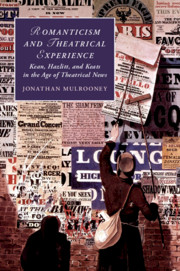Book contents
- Romanticism and Theatrical Experience
- Cambridge Studies in Romanticism
- Romanticism and Theatrical Experience
- Copyright page
- Dedication
- Contents
- Figures
- Acknowledgments
- Introduction
- Part I The Making of British Theater Audiences
- Chapter 1 Theater and the Daily News
- Chapter 2 Britain’s Theatrical Press, 1800–1830
- Part II Theater and Late Romanticism
- Bibliography
- Index
- Cambridge Studies in Romanticism
Chapter 2 - Britain’s Theatrical Press, 1800–1830
from Part I - The Making of British Theater Audiences
Published online by Cambridge University Press: 31 December 2018
- Romanticism and Theatrical Experience
- Cambridge Studies in Romanticism
- Romanticism and Theatrical Experience
- Copyright page
- Dedication
- Contents
- Figures
- Acknowledgments
- Introduction
- Part I The Making of British Theater Audiences
- Chapter 1 Theater and the Daily News
- Chapter 2 Britain’s Theatrical Press, 1800–1830
- Part II Theater and Late Romanticism
- Bibliography
- Index
- Cambridge Studies in Romanticism
Summary
- Type
- Chapter
- Information
- Romanticism and Theatrical ExperienceKean, Hazlitt and Keats in the Age of Theatrical News, pp. 57 - 106Publisher: Cambridge University PressPrint publication year: 2019



